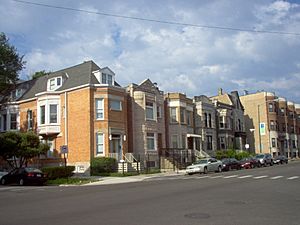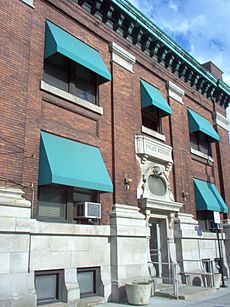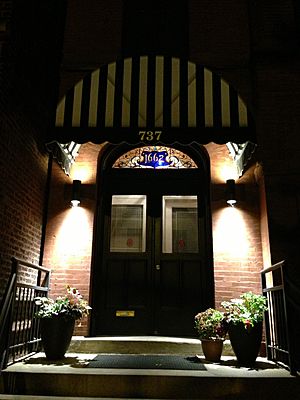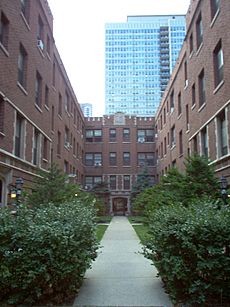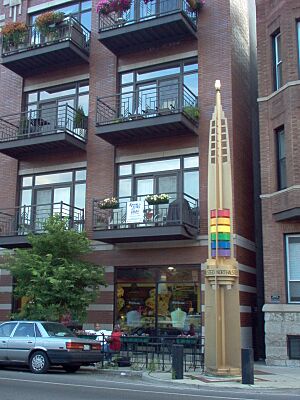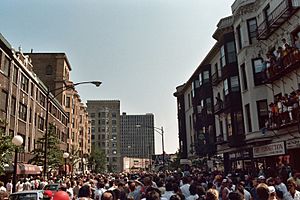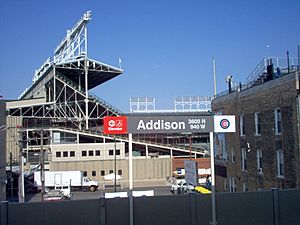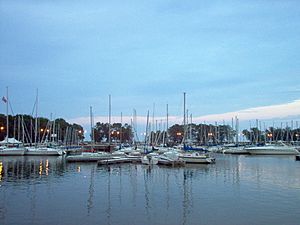Lake View, Chicago facts for kids
Quick facts for kids
Lakeview
|
|
|---|---|
| Community Area 6 - Lakeview | |

Looking across Belmont Harbor toward Lakeview
|
|
| Nickname(s):
Little Michigan
|
|
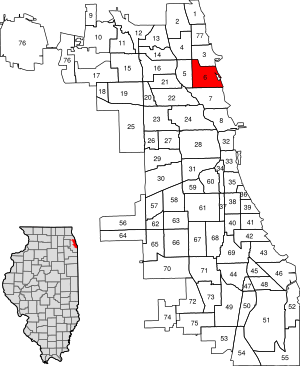
Location within the city of Chicago
|
|
| Country | United States |
| State | Illinois |
| County | Cook |
| City | Chicago |
| Neighborhoods | |
| Area | |
| • Total | 3.13 sq mi (8.10 km2) |
| Population
(2020)
|
|
| • Total | 103,050 |
| • Density | 32,950/sq mi (12,722/km2) |
| Demographics 2021 | |
| • Non-Hispanic White | 75.6% |
| • Black | 4.3% |
| • Hispanic | 9.1% |
| • Asian | 7.2% |
| • Other | 3.8% |
| Educational Attainment (2021) | |
| • High School Diploma or Higher | 98.2% |
| • Bachelor's Degree or Higher | 83.3% |
| Time zone | UTC-6 (CST) |
| • Summer (DST) | UTC-5 (CDT) |
| ZIP codes |
parts of 60613, 60657
|
| Area code(s) | ZIP Codes |
| Median household income (2021) | $95,173 |
| Source: U.S. Census, Record Information Services | |
Lakeview is one of the 77 community areas in Chicago, Illinois. It is located on the city's North Side. Lakeview is bordered by West Diversey Parkway to the south and West Irving Park Road to the north. North Ravenswood Avenue is its western border, and the shore of Lake Michigan is its eastern border.
Lakeview is a very popular place. In 2020, about 103,050 people lived there. This makes it the second-largest community area in Chicago by population. It is known for its many neighborhoods. These include Wrigleyville, home of the Chicago Cubs, and Northalsted, a lively area with rainbow pylons. Lakeview also has the Belmont Theater District. This area has over 20 theaters and live performance spots. In 2013, Money Magazine called Lakeview one of the top ten big-city neighborhoods to live in.
Contents
History of Lakeview
Lakeview has a long and interesting history. It started as a place for Native American tribes. Later, it became a growing town before joining Chicago.
Early Settlement
Long ago, Lakeview was a camping and trail area for the Miami, Ottawa, and Winnebago Native American tribes. In 1837, Conrad Sulzer from Switzerland became the first known European settler. In 1853, the first permanent building was the Hotel Lakeview. It was named for its clear view of Lake Michigan. People thought of it as a resort.
The area grew with English, German, Luxembourg, and Swedish farming families. Many people moved to Lakeview when Chicago had a serious cholera outbreak. The Hotel Lakeview became full of people seeking safety. More houses were built, and a wooden plank road connected the area to Chicago. This road is now North Broadway. As more people moved in, residents decided to create a formal government. They wanted to provide important public services.
Lakeview Township
Lakeview was once its own town with its own government. It was separate from Chicago. The first town election was held in 1857. The main building was Town Hall, which is still there today. It was once a police station. Lakeview Township covered a large area. It included parts of what are now Edgewater, Uptown, Lakeview, and Lincoln Park.
During the American Civil War, a training camp called Camp Fry was in Lakeview. It trained soldiers for the Union Army. Later, it became a prison for Confederate soldiers. The few people living in Lakeview Township sometimes heard the rebel soldiers singing.
Lakeview's early main business was farming, especially growing celery. It was even called a "celery-growing capital." From 1870 to 1887, the population grew from 2,000 to 45,000 people. Because of this growth, Lakeview needed more public services. So, in 1889, Lakeview joined Chicago. At that time, there was a big boom in building new homes and businesses. More than 40% of Lakeview's buildings today were built during this period.
Street Names
Many streets in Lakeview are named after important people or events. West Addison Street is named after Thomas Addison, an English doctor. West Barry Avenue is named after John Barry, a naval commander from the Revolutionary War. West Belmont Avenue gets its name from the American Civil War's Battle of Belmont.
North Broadway used to be called Evanston Avenue. It was renamed after Broadway in New York City. North Clark Street is named after the famous explorer George Rogers Clark. West Diversey Parkway is named after Michael Diversey, a beer brewer. North Halsted Street is named after financiers William H. and Caleb Halsted. It was once called Dyer Street, after Chicago Mayor Thomas Dyer. West Irving Park Road is named after the author Washington Irving.
A large statue of General Philip Sheridan on horseback stands at West Belmont Avenue and North Lake Shore Drive. Sheridan Road is named after him. He helped Chicago after the Great Chicago Fire in 1871. He later became a top general in the U.S. Army.
Famous People from Lakeview
Many interesting people have lived in Lakeview. Here are a few:
- John Peter Altgeld (1847–1902) was the 20th Governor of Illinois.
- Charlie Chaplin, the famous silent film comedian, lived here in 1915.
- Buckminster Fuller (1895–1983) was a well-known inventor.
- Paul Harvey (1918–2009) was a popular radio broadcaster.
- Cody Keenan was the Director of Speechwriting for President Barack Obama.
- Minnie Miñoso was a pioneering baseball player for the Chicago White Sox.
- Mike Royko (1932–1997) was a Pulitzer Prize-winning newspaper writer.
Lakeview Communities
Lakeview is divided into different areas. These include Lakeview East and Lakeview West. Lakeview East has special areas like Wrigleyville and Northalsted.
Lakeview East
Lakeview East is a large part of the Lakeview area. Its borders are Lake Shore Drive to the east, Racine to the west, Diversey Parkway to the south, and Irving Park to the north. This area includes two of Chicago's biggest entertainment spots: Wrigleyville and Northalsted.
Lakeview East has many upscale apartments and mid-rise buildings. You can find small businesses, unique shops, and restaurants along North Broadway and North Halsted Street. Many historic churches are also part of the community. These include Lakeview Presbyterian Church and Saint Peter's Episcopal Church. Our Lady of Mount Carmel Church is also here.
The Lakeview Historic District is in this area. It is listed on the National Register of Historic Places.
Wrigleyville

Wrigleyville is the neighborhood right around Wrigley Field. This is the home stadium of the Chicago Cubs baseball team. Its borders are Grace Street to Cornelia Avenue (north to south) and Wilton Avenue to Racine Avenue (east to west).
Wrigleyville has many brick buildings and houses. Some of these homes have special rooftop seating. People can buy tickets to watch baseball games or concerts from these rooftops. Many bars and restaurants in Wrigleyville have sports themes. Places like Sluggers and Murphy's Bleachers are popular spots for Cubs fans.
Northalsted (formerly Boystown)
The Northalsted section of Lakeview is known for its welcoming community. In 1998, the city worked to improve the North Halsted Street area. They put up rainbow pylons along the street. These pylons now have plaques that honor important people and events in history. This area is a cultural center for many people in Chicago.
Northalsted is famous for its lively nightlife. It has many restaurants and entertainment venues. It is also home to Center on Halsted. This is a community center that offers many programs for everyone.
The area hosts a large community parade each June. It also holds the Northalsted Market Days. This is a two-day festival with bands and other entertainment. Northalsted also has theaters, unique restaurants, and historic buildings. You can find trendy shops and independent stores here too.
The area's borders are Irving Park Road to the north, Broadway to the east, Wellington Avenue to the south, and Sheffield Avenue to the west.
In 2020, some businesses and groups started using the name "Northalsted" instead of "Boystown." This was to be more inclusive. Even with the name change, many people still call the area Boystown. Some residents worry the name change might make the neighborhood's history less clear.
Lakeview West
West Lakeview is near the Roscoe Village area. A local group defines West Lakeview as the area bounded by West Addison Street to the north, West Diversey Parkway to the south, North Southport Avenue to the east, and North Ravenswood Avenue to the west. This area is known for its affordable homes and popular culture. Many young adults come here for quiet living or casual dining.
The Music Box Theatre opened in 1929 just north of West Lakeview. It is known as "Chicago's year-round film festival." Dinkel's Bakery was a famous spot in West Lakeview for 100 years, from 1922 to 2022.
Sheridan Station Corridor
The Sheridan Station Corridor is a small area around the Sheridan 'L' station. It is located on Sheridan Road, between Irving Park Road and Byron/West Sheridan Street. This area was once called "Restaurant Row" because of its many eateries. It is seen as a connection between Uptown to the north and Lakeview to the south.
Services in Lakeview
Lakeview offers many services for its residents.
Places of Worship
Lakeview has many different places of worship. These include:
- Anshe Emet Synagogue
- Anshe Sholom B'nai Israel Congregation
- Broadway United Methodist Church
- Chabad of Lakeview
- Our Lady of Mount Carmel Roman Catholic Church
- Saint Alphonsus Roman Catholic Church
- Saint Andrew Roman Catholic Church
- Temple Sholom
Getting Around (Transportation)
Getting around Lakeview is easy with public transportation. The Chicago Transit Authority (CTA) provides train and bus services. Lakeview has six 'L' train stations:
- Addison (Red Line)
- Belmont (Red, Brown, Purple Lines)
- Paulina (Brown Line)
- Sheridan (Red Line)
- Southport (Brown Line)
- Wellington (Brown and Purple Lines)
The CTA also runs many bus routes in Lakeview. Some buses go directly to downtown Chicago. You can also find taxis and limousines. Bicycle rickshaws are popular near Wrigley Field. Bike paths are becoming more common on streets. There are also walking and running paths, especially along the lakefront.
The Chicago Marathon training path goes around the Belmont Harbor marina. This marina has many spots for boats and yachts. It is also home to the Belmont Yacht Club.
Fun and Entertainment
Lakeview has many places for fun and entertainment:
- Theaters:
- Alamo Draft House
- Athenaeum Theatre
- Annoyance Theatre
- ComedySportz
- Briar Street Theater
- The Music Box Theatre
- Stage 773
- Music Venues:
- Metro Chicago
- Vic Theatre
- Sports:
Learning and Schools (Education)
Students in Lakeview attend Chicago Public Schools.
- Elementary Schools: Agassiz, Greeley, Hamilton, Ravenswood, Nettelhorst, Blaine, and Burley.
- High Schools: Most students go to Lake View High School. Some go to Lincoln Park High School.
- Magnet Schools: Inter-American Magnet School (IAMS) and Hawthorne Scholastic Academy are in Lakeview.
Libraries
Lakeview has many libraries for learning. The John Merlo Branch of the Chicago Public Library has a large collection of books. It also has special collections on African American history, Chicago history, and Jewish culture.
Kwagulth Totem Pole
In the Lakeview part of Lincoln Park, there is a totem pole called Kwanusila. It represents the Thunderbird of the Kwagu'ł Native American tribe. It was carved from Red Cedar by Tony Hunt. The totem pole shows the Thunderbird, a whale with a man on its back, and a sea monster.
Totem poles were traditionally used by First Nations along the coast of British Columbia. Kwanusila is a copy of an older totem pole that was given to Chicago in 1929. The original pole was later returned to British Columbia. Kwanusila was given to Chicago in 1986. It is dedicated to the school children of Chicago.
This totem pole is easy to see from Lake Shore Drive. It is marked on Chicago maps as a place to visit. Many residents and tourists come to see it. It stands in front of the Jarvis Migratory Bird Sanctuary.
Events in Lakeview
Lakeview hosts many exciting events throughout the year.
A big part of the Bank of America Chicago Marathon runs through Lakeview East. Spectators line the sidewalks to cheer on the runners. The annual Bike the Drive event also goes through Lakeview East. This event lets people ride their bikes on Lake Shore Drive.
Lakeview also has many art events. In the spring, there are gallery tours. In September, the Lakeview East Festival of the Arts takes place on North Broadway. Over 150 artists show their work. There is also live entertainment and food.
One of the biggest events is the annual community parade. It is held on the last Sunday of June. It goes along North Broadway, North Halsted Street, and West Diversey Parkway. In August, the Northalsted Market Days festival closes off North Halsted Street. This popular street fair has famous bands and other entertainment. There are also food and merchandise booths.
Smaller events happen all year. In July, the Lakeview Garden Walk takes visitors on tours of over eighty gardens. These gardens are prepared by residents. Families with children enjoy the Easter egg hunt at Nettelhorst Elementary School. They also have a costume parade and storytelling for Halloween. Halloween is also a time for a big costume contest on North Halsted Street.
| Month | Event | Location |
|---|---|---|
| Spring | Race to Wrigley | Addison and Clark |
| May | Bike the Drive | North Lake Shore Drive |
| May | Belmont-Sheffield Music Fest | On Sheffield between Belmont Avenue and School Street |
| June | Community Parade | North Broadway at North Halsted Street |
| July | Summer on Southport | Southport Corridor |
| August | Northalsted Market Days | North Halsted Street |
| September | Taco Fest | Southport Corridor |
| September | Lakeview East Festival of the Arts | North Broadway at West Belmont Avenue |
| October | Bank of America Chicago Marathon | North Lake Shore Drive, North Broadway |
| October | Halloween Parade | North Halsted Street |
| October | Halloween Kids | Nettelhorst Elementary School |
Images for kids
See also
 In Spanish: Lake View (Chicago) para niños
In Spanish: Lake View (Chicago) para niños



